Dynamite Valley
It's fall, and that means it's blasting season!
The beavers here in Dynamite Valley Park have been working overtime, making dams! If I've told you once, Ranger Jim, I've told you a thousand times-- now get out there and blast those consarned dams!
Guide Ranger Jim around a series of levels infested with beaver dams damming up the waters of Dynamite Valley Park.
Requires Python 3.6 or newer, current Pyglet, and current PyGame. If you've got those, just unzip and run
% python run_game.py
Check the README.md for detailed gameplay instructions and everything else.
Oops, forgot one thing: Remote-control bombs are triggered with the T key. Those are the bombs with the red ring near the fuse. They're only on a couple of levels!
p.s. we recommend the tutorial!
github.com/larryhastings/pyweek26
Awards
Scores
Ratings (show detail)
Overall: 4.2
Fun: 4
Production: 4.5
Innovation: 4.1
Files
| File | Uploader | Date |
|---|---|---|
|
dynamite-valley-1.0.2.zip
— final
Dynamite Valley 1.0.2 |
larry | 2018/10/28 23:27 |
|
dynamite-valley-1.0.1.zip
— final
Dynamite Valley 1.0.1 |
mauve | 2018/10/28 14:26 |
|
dynamite_valley.zip
— final
Dynamite Valley |
larry | 2018/10/28 00:08 |
|
day7-4.png
Moving around with bombs |
mauve | 2018/10/27 01:19 |
|
screencast.mkv.gif
Bombs queue, a-splode, and push! |
larry | 2018/10/26 00:53 |
|
day4.gif
Picking up and dropping |
mauve | 2018/10/25 00:57 |
|
day3-2.gif
Floating bombs |
mauve | 2018/10/24 01:03 |
|
day3.gif
Explosions |
mauve | 2018/10/23 19:53 |
|
day2.gif
Water flow and dropping bombs |
mauve | 2018/10/23 01:04 |
|
day2-2.png
Tilemapped world |
mauve | 2018/10/22 21:03 |
|
day1-1.png
Player character on screen |
mauve | 2018/10/21 22:14 |
Diary Entries
Day 1-2
Tonight feels like starting in earnest for me. The rough split at the moment is that I'm doing graphics and Larry is doing gameplay. Today I've added tilemap rendering for the level, as well as a scenegraph for game objects and a particle system that indicates the water flow. Larry has worked on our tile-based movement.
This animation shows off pretty much where we are:
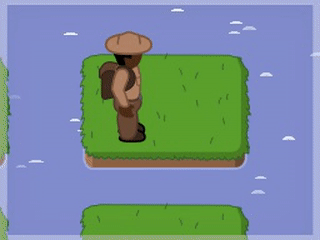
Day 3
We make a lot of progress today; both the visual style and the game mechanics are coming along.
I drew some explosions using Inkscape. Animation is one of those things that is hard in Inkscape, but I've become practiced at anyway, so I think this looks Ok:
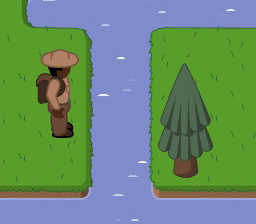
Larry has been hard at work on the flow mechanics as well as being able to interact with objects already in the world:
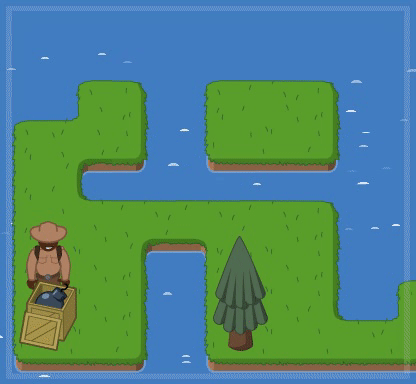
While I think we can create puzzles using these mechanics, the details aren't completely worked out. I started sketching some notes on this on paper. But we have a text-based level format that will allow us to iterate quickly, and we have 4 days to iterate on the puzzles, so that seems like enough time.
Communing with nature
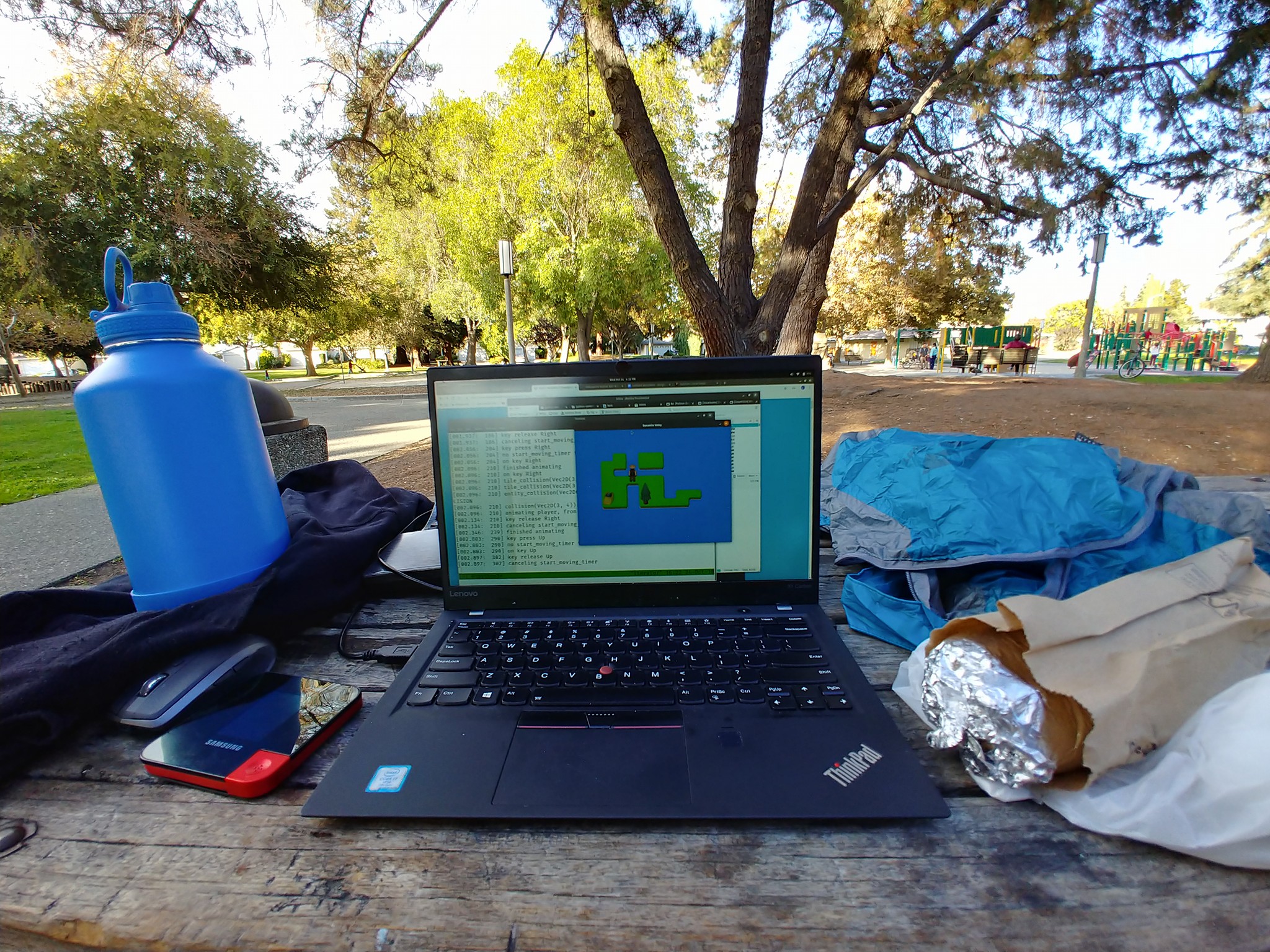
Since our game is nature-themed, I took advantage of our lovely clement weather--I took my laptop (and a burrito) out to the park! Ah, the birds chirping, the perfect background for game development. :D
Bombs queue, skip, a-splode, and push!
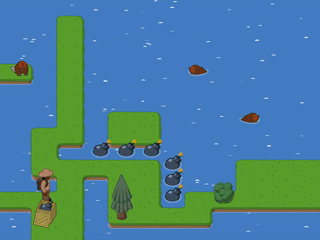
Look at all this technology showcased in this GIF! (And please excuse the occasional screen tearing--it's a side-effect of the screen capture program I used.)
- Bombs sitting in moving water get pushed along by the water.
- If multiple streams of bombs meet at one tile, they take turns moving into the contested tile.
- You can walk on top of floating bombs.
- You can skip bombs along the tops of floating bombs!
- Bombs that explode push away nearby bombs!
- Poor Ranger Jim can be all a-burned up if he gets too close to an exploding bomb.
Pardner, them there's what we call game mechanics.
Day 7 (and some bugs)
Aargh, game breaking bugs introduced at the last minute! As is customary I've uploaded a 1.0.1 with bugfixes for game-breaking issues only. I've played end-to-end now and the game is completeable.
I've not done many diary entries over the latter part of the week, despite posting a few screenshots. I was posting animations and then realised that this might include spoilers so I slowed down ;-)
As always it was a race to the finish line, and the level design was mainly left until last. We have a great engine, but only 11(?) full levels. I think there are some real challenges in there, though, so hopefully it's a good amount of content. If you can decode the level text-file format you can try creating your own levels.
I'm very happy with the game, on the whole. It is cute and colourful and challenging and satisfying. I hope you enjoy it!
The Player's Guide To Dynamite Valley
We've rewritten the README.md for Dynamite Valley. I've pasted it in below in the hope that PyWeek participants will see it and have a better time playing Dynamite Valley as a result.
The Player's Guide To Dynamite Valley
It's fall, and that means it's blasting season!
The beavers here in Dynamite Valley Park have been working overtime, making dams! If I've told you once, Ranger Jim, I've told you a thousand times--we need you to blast those consarned dams!
Guide Ranger Jim around a series of levels infested with beaver dams damming up the waters of Dynamite Valley Park.
"Dynamite Valley" is an exciting action game written by Daniel Pope and Larry Hastings for the "PyWeek 26" programming competition in October 2018. This guide will explain to you everything you need to know to play Dynamite Valley.
We sincerely hope you have fun playing! Now get out there and wipe out those dams!
You play as Ranger Jim, a park ranger at Dynamite Valley Park. Your job: remove the dams infesting the park's beautiful waterways! With explosives!
Every level has a number of "dams" floating in the water. Ranger Jim has to destroy all the dams to advance to the next level. If you complete all the levels, you win!
Both Dan and I played through the final version of the game, version 1.0.2. Every level is winnable! We guarantee it!
Note that on some levels you can put yourself into a situation where the level is no longer winnable. For example, on some levels you only have a limited supply of bombs, and if you misuse them the level may no longer be winnable. If you think that's happened, you should start the level over.
Also, the first zip file release of "Dynamite Valley" had a game-breaking bug. We guarantee that version *isn't* winnable! 1.0.1 had a minor bug that could be worked around. 1.0.2 and anything newer should work great!
Dynamite Valley requires Python 3.6 or higher.
Check the requirements.txt for what you'll need.
Dynamite Valley needs both PyGame and Pyglet.
You might be able to install all Dynamite Valley's requirements automatically by running this:
% sudo pip3 install -r requirements.txt
Your mileage may vary!
We recommend running Dynamite Valley with "python3 -O". Pyglet's Open GL support occasionally, if rarely, throws assertion failures. If you use the provided launcher `run_game.py` we do this for you.
Once you start the game, at any time during the title sequence you can press one of three keys to start your game:
T - Start the tutorial (recommended!).
N - Start a new game.
Space - Play the game starting at the last level you played.
Every time you start playing a level, the game remembers that, and if you exit the game and restart, pressing Space will take you straight to that level. (It won't remember where you were, though--it'll just reload the level from scratch.)
In the game, you control Ranger Jim, a park ranger working in "Dynamite Valley".
"Dynamite Valley" supports the following keyboard commands in-game:
Up Down Left Right - move Ranger Jim, or change which direction he is facing
W A S D - redundant movement controls
E - interact with the object Ranger Jim is facing, like take a bomb from a dispenser, or pick up an inert bomb from the ground
B - drop a bomb, onto the spot where Ranger Jim is facing
T - trigger a Remote Control Bomb
Escape - pause game, bringing up the Pause Menu
F5 - restart level
F12 - take screenshot
Ranger Jim can pick up up to two bombs at a time. When he drops a bomb, he drops the bottom bomb from the stack. That's always the most recent bomb he picked up.
Dynamite Valley doesn't support joysticks or the mouse.
Ranger Jim does his work with bombs. As we all know, bombs "detonate", turning them into explosions which "blast" nearby objects. Specifically, exploding bombs in Dynamite Valley "blast" their four nearest neighbors (up/down/left/right). Bombs on land can still blast objects floating in the water, and bombs in the water can still blast objects on land.
Bombs that Ranger Jim drops are automatically armed. Ranger Jim can't pick up a bomb that's been armed.
There are four types of bombs in the game:
- Timed Bombs are the most frequently-seen type of bomb. They look like the classic movie bomb: a black circle with a small black cylinder near the top, and a fuse. They detonate 5 seconds after being dropped. When "blasted", Timed Bombs are "flung" one space away.
- Contact Bombs look like black spheres with little round nubs poking out in all directions. They're very sensitive! Contact Bombs automatically detonate when they're pushed into something, or when they're blasted by another bomb.
- Remote Control Bombs look like Timed Bombs but with a red ring around the small cylinder at the top. You detonate an RC Bomb with the "T"rigger key. RC Bombs detonate one at a time, in the order you dropped them--if you drop five bombs, you have to press "T" five times to trigger them all. Remote Control Bombs that are blasted are "flung" like Timed Bombs.
- Freeze Bombs look like Timed Bombs, except they're white and they have light blue snowflakes drawn on the side. They detonate 2 seconds after being dropped. Freeze Bombs that get "blasted" are "flung" like Timed Bombs. However! Instead of "blasting" their neighbors, Freeze Bombs "freeze" their neighbors:
- Frozen Timed Bombs and Frozen Freeze Bombs pause their countdown for 5 seconds.
- Frozen Contact Bombs are desensitized to impacts for 5 seconds.
- Freezing doesn't affect Remote Control bombs.
There are a lot of decorative objects that are immune to blasting and freezing: trees, rocks, and--strangely enough--beavers and bullrushes. However, you can destroy bushes by blasting them.
If Ranger Jim gets blasted or frozen, the level is over and you have to restart.
Most water is still water. However, some water is flowing in a particular direction. You can tell what water is flowing water by paying attention to the ripples in the water: when the ripples are moving, that shows you what direction that patch of water is flowing in.
Flowing water will push objects along, like floating logs or bombs dropped into water. Objects in flowing water move at the rate of one screen tile per second.
Objects in flowing water that get pushed up against something get stuck. (Unless the object is a Contact Bomb--in which case, it explodes!) Once the obstacle is removed the object will resume floating along.
Ranger Jim can step on most floating objects. There are only a few he can't, like beavers and bullrushes. If Ranger Jim steps on a floating object that's in flowing water, he can ride on top!
Ranger Jim can't pick up any object that's floating in water.
If Ranger Jim falls in the water, the level is over and you have to restart. But don't worry, Ranger Jim won't walk into water--he stops at the shore automatically.
Objects can occasionally move very quickly. This is called being "flung".
Objects can get flung two different ways:
- Timed Bombs that get "detonated" are flung one square away from the explosion.
- When Ranger Jim drops a bomb on top of a floating object, the bomb is "flung" over the object, heading away from Ranger Jim. If there is a series of floating objects all in a row, the bomb will "skip" along all of them until it lands in open water... or on a distant shore!
You can make your own Dynamite Valley levels!
First, open up the "src/levels" directory. Dynamite Valley levels are individual text files in this directory. The easiest way to make a new level is to copy an existing level, then edit it however you like. Edit the level in your favorite text editor, then save your new text file in "src/levels" with the ".txt" file extension. You can play your own levels with "run_game.py <name of level>". For example, if you name your level "fred.txt", you can play it with "run_game.py fred".
Here's a quick description of the level format. Levels are text files, using simple ASCII files. Each level text file has three sections: the "tile map", followed by the "legend", and finally the "metadata".
The first section is the "tile map" for the level. This must be exactly be 12 characters across and 13 characters tall. The "tile map" is a sort of ASCII art drawing of the level, where one character maps to one tile on the screen.
After the "tile map" there should be one or more blank lines, and after those blank lines should be the "legend".
The "legend" establishes what the characters of the tile map represent. A "legend" line is a single character, followed by a space, followed by a definition of what that character represents in the "tile map". There's also a default "legend.txt" shared by all levels containing all the most commonly-used tiles.
(What are the possible legal "definitions" for a legend line? It's hard to describe. Just find a tile in the game that does what you want, and look in the level where it was used to se what the relevant "legend line" was.)
After the "legend" there should be one or more blank lines, followed by the "metadata".
The "metadata" establishes various other facts about the level. The format of a "metadata" line is: a noun with a colon at either end, followed by one or more spaces, followed by the value for that metadata.
Here are all the valid nouns for metadata lines:
- :title: The name of the level, displayed at the loading screen.
- :hint: The "hint" for the level, displayed at the loading screen.
- :author: The "author" for the level, displayed at the loading screen.
- :next: The name of the next level. When the player finishes this level, the game will automatically switch to this level.
The only required metadata is "next". All the others are optional and have sensible default values.
Some ideas we didn't have time to explore during PyWeek 26:
- Giant Bombs, which blast all squares within a "Manhattan distance" of 2.
- Moving beavers, which would swim back and forth in a predictable pattern. Swimming beavers would push any floating object (including a Contact Bomb, which it would not set off). Blasting a beaver would be an automatic level failure--you can't hurt the wildlife, you're a park ranger!





